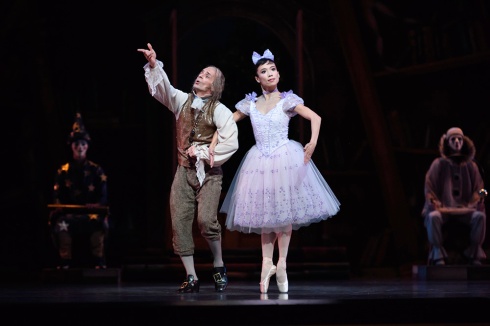When you park off Wawona for a Sunday Stern Grove matinee, the path to the
meadow-auditorium as remodeled by the late Lawrence Halprin does three or four turns on its sloping route to the wonderful meadow given to San Francisco by Mrs. Sigmund Stern honoring her husband. You come out near the clubhouse which some decades earlier was a roadhouse and now houses a series of both gender toilets adjoining the original building. A few feet downward and there are a slew of short-order vendors and the Stern Grove Association booths for information and assistance.
As VIP’s [read press affiliates] it was still necessary to trek across the meadow, brimming with multi-cultural humanity, to the VIP tent to get badges and green wrist bands enabling our party of five to imbibe beer and wine as well as claim our share of Table 35, next to the bona fide press table. This year the press has been moved to the lower of three tiers of tables, if off side, so that our view of San Francisco Ballet was decidedly at an angle. It also enabled us to observe Frances Chung stretch her legs and bend her back prior to entering as Odette in Swan Lake, her debut in the role. She doubtless will appear in the ballet during the 2017 spring season at the Opera House.
In addition to Tiit Helimets as Siegfried and Alexander Renoff-Olson as Von Rothpart, the program included Helgi Tomasson’s Fifth Season, music by Welsh composer Karl Jenkins and two pieces appearing semi-regularly on SFB’s programs: Christopher Wheeldon’s After the Rain pas de deux to Estonian composer Arvo Part, finishing with George Balanchine’s Rubies with Vanessa Zahorian, Joseph Walsh and Jennifer Stahl.
Before further comment, our party of five included Carlos and Carolyn Carvajal, who have graced performances and mounted works locally both in the earlier San Francisco Ballet days, with Carlos’ Dance Spectrum and Carolyn’s witty performances with Dance Through Time and in the ballet parts of San Francisco Opera seasons. Carlos’ tenure with San Francisco Ballet goes back to Willam Christensen’s years, and two subsequent stints under Lew Christensen with Le Grand Ballet de Marquis de Cuevas, Breman and Bordeaux Opera Ballets in between.
Dennis Nahat and John Gebertz made numbers three and four, both having assignments with Akyumen Technologies since Nahat’s abrupt termination at Ballet San Jose, bringing two Chinese productions to De Anza Auditorium in Cupertino and Southern California, and participating in the affairs of Donald McKayle at U.C. Irvine. Dennis regaled us with stories of ABT’s Swan Lake in the rain at New York’s Delacorte Theater and the ingenuity of Lucia Chase.
Swan Lake brought swoons of admiration from Carolyn Carvajal for the dancing of the corps de ballet, remarking on the correctness of the staging as she remembered it with Merriem Lanova’s Ballet Celeste. Dennis observed how crisp the angles in the line of foot and leg in Odette’s solo because of short tutus, unlike the knee-length costumes so remarked upon in Ratmansky’s production of Sleeping Beauty. We had to assume Tiit’s interpretation because his back was to us ninety per cent of the time, but Chung’s expression provided the clue of Odette’s concern and wavering. For the first time I could feel a thought process from the progression of Odette’s choreography, as well as the touching moment when she ventures under Siegfried’s arm in the pas de deux, a creature moment for certain.
Wan Ting Zhao and Jennifer Stahl provided the leaping choreography and Isabella DeVivo, Jahna Frantziskonis, Noriko Matsuyama and Emma Rubinowitz, precise, multi-cultural little cygnets, hopping in sync for all their worth.
Tomasson’s Fifth Season was garbed in Sandra Woodall’s sleek tight and top fashion de rigeur with choreographic abstraction, divided into sections titled Waltz, Romance, Tango, Largo and Bits, eight corps in the ensemble with principals Mathilde Froustey, Yuan Yuan Tan, Doris Andre , the men Carlos Quenedit, Tiit Helimets, Aaron Robison in his local San Francisco Ballet debut.
Yuan Yuan Tan seemed to have cornered the feminine role in After The Rain
pas de deux, her sinuous,willowy length adapting to Luke Ingham, a second
Australian to partner her in Christopher Wheeldon’s protracted study of langeur
and emotional connection, minimally costumed in flesh tones by Holly Hynes. Ingham made an effective foil to Tan, clearly an excellent partner.
Rubies is, to me, a very urban ballet, brash, out there with a neat dash of Broadway. Jennifer Stahl danced the figure manipulated by the four corps men Max Cauthorn , Blake Kessler, Francisco Mungamba and John-Paul Simoens. From a distance it seemed effective, given location reservations and the vivid memory of Muriel Maffre in that role. Vanessa Zahorian and Joseph Walsh danced the leads with aplomb and good humor.
San Francisco Ballet annually draws some of Stern Grove Festival’s biggest audiences. Halprin’s design gives the public an amazing series of alcoves where they can stash their bodies and their lunches. Halprin’s vision reinforced that fact Stern Grove Festival, at the threshold of celebrating its 80th annual summer, continues to be one of the crown jewels of San Francisco’s cultural and recreation diversions.

